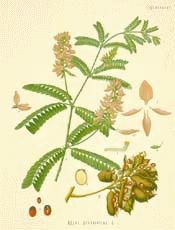
Botanical.com Home Page

|
Rosarypea
(Abrus precatorius LINN.)
Click on graphic for larger image
|
Liquorice, Indian
Botanical: Abrus precatorius (LINN.)
Family: N.O. Leguminosae
---Synonyms---Jequirity. Wild Liquorice. Prayer Beads.
(Indian) Gunga. (Indian) Goonteh. (Indian) Rati.
---Parts Used---Root, seeds.
The root of an Indian leguminous plant, Abrus precatorius (Linn.), under the native names of Gunga or Goonteh, has been used as a demulcent. It contains Glycyrrhizin, and has been termed Indian Liquorice and used as a substitute for true Liquorice. Acrid resins, however, render the root irritant and poisonous.
An infusion and a paste of the seeds are included in the British Pharmacopoeia. It has a strongly irritating effect upon the eyes and has been used both to produce and to allay certain ophthalmic diseases.
The hard, red, glossy seeds, nearly globular, with a large, black spot at one end, are known as Prayer Beads, or Jequirity seeds. The seeds, weighing about 1 carat each, have been used in India from very ancient times for the purpose of weighing gold, under the name of Rati. They are largely employed also for the making of rosaries and for ornamental purposes.
The weight of the famous Koh-i-noor diamond was ascertained by means of these seeds.
There is also a variety with perfectly white seeds.
Their medical importance is not great, but they have a notorious history in India as an agent in criminal poisoning. This practice has been directed chiefly against cattle and other live stock, but the poisoning of human beings has been not infrequent. That the attractive seeds form dangerous playthings for children has been proved by the records of a number of cases of poisoning which have occurred in this way.
The name Wild Liquorice has also been given to Aralia nudicaulis (Linn.), indigenous to Canada and the United States, and to the root of Cephalanthus occidentalis, a member of the Madder family, a large shrub, with rich, glossy foliage, growing in swamps almost throughout the United States and extending into Southern Canada, the bark and stem of which is used commercially.
Rest-Harrow has also been called Wild Liquorice.
[Top]
Common Name Index
A MODERN HERBAL Home Page
Bear in mind "A Modern Herbal" was written with the conventional wisdom of the early 1900's. This should be taken into account as some of the information may now be considered inaccurate, or not in accordance with modern medicine.
© Copyright Protected 1995-2025 Botanical.com
|

